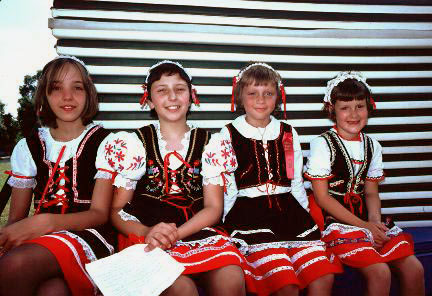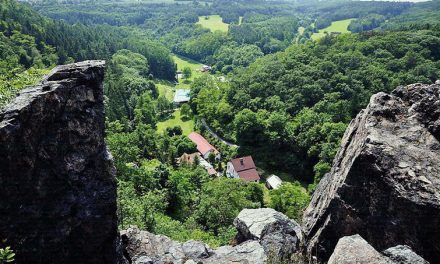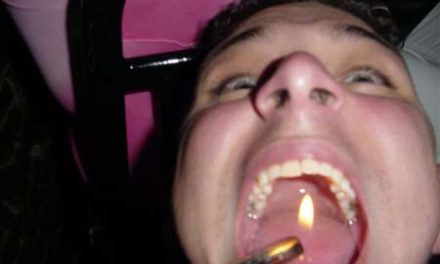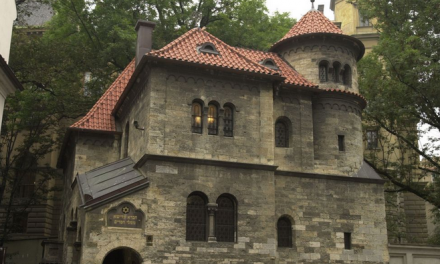I’ll get my money’s worth too, considering that Prague is more than one city. Rather it’s a patchwork of small towns: Old Town, New Town, and Lesser Town, each with its own town square. These town squares are among the most endearing of Prague’s charms. Not Hollywood but Old Town Square and its Tyle Theater, both hardly changed since Mozart’s day, served as sets for the smash film Amadeus.
Today tourists crowd the center of the Square waiting for the fifteenth century astronomical clock in the Town Hall Tower to do its hourly thing: ring Christ and the Apostles out of the tower on one side, in on the other. After this hallowed parade the crowd melts and it’s easier to poke around. That’s when we discovered the towers of the late Gothic Tyn Church. Tyn School is also Gothic but with gables reminiscent of Venetian Renaissance; for an outstanding example of Prague Baroque, there’s the Church of St. Nicholas. Gothic, Renaissance, Baroque: that’s Prague anywhere you turn.
After hours of craning at red – tiled roofs, Gothic spires, Baroque gables and Rococo lintels we need a café. A glass of Pilsner (the Prince of Beers) and a ham sandwich (Prague’s ham is the best) will see us through the next round of sightseeing.
Not far from Old Town, adjacent to the Square of the Knights of the Cross, is the Clementinum. Originally a Jesuit college, it now houses the Czech Republic’s state libraries. Doors along cloistered walks arouse our curiosity; the doorkeeper gave his approval for us to enter one of them. Beyond the door, the periodicals room blends past and present. Walls soaring to some forty – feet, book – lined balcony, faded ceiling mural, total quiet, all recall the library’s monastic roots. A porcelain stove curving in Baroque grace reflects a more opulent time. Researchers in blue jeans are as contemporary as tomorrow. What a place to be a scholar!
In the winter of ’89 – ’90, scholars poured out of Charles University and Clementinum to join demonstrators on Wenceslas Square. Every night for weeks, TV news made that Prague thoroughfare as familiar as Times Square on New Year’s Eve – but in name only. For all the television exposure we never saw the Square itself. With the fall of communism, Wenceslas Square is once again the fashionable center of this vibrant old city.
And that’s how we saw it when we emerged from the metro at the National Museum Station, not as a square but a long broad boulevard sweeping down from the larger than life statue of Good King Wenceslas. The Square that bears his name is Prague’s Fifth Avenue and pedestrian traffic is heavy along its wide sidewalks; it’s a great place for window-shopping. I fell in love with everything: garnets mined in the Czech Republic; porcelain, its shapes and patterns exquisite; ruby – red and cobalt – blue Bohemian glass.
Half way down the boulevard we settled in for lunch at the Jalta Hotel, once renovated but still full of old world charm and still serving old world dumplings. Had we wanted something light, the stand-up pizza restaurants at the bottom of the Square is popular with shoppers; or we might have tried sausage snacks at window counters all along the boulevard. Back at the National museum, having circled the Square, we wandered through the science exhibits; the mineralogy collection is world famous.
But it was the assortment of hand puppets going back to the eighteenth century that most delighted us. I could picture a small table on a street corner or in a town square with Punch and Judy going at each other to the delight of the crowd.
A few blocks up from the museum is the Smetana Theater. We were lucky to get seats for that evening’s performance and a table for dinner at the Esplanade Hotel across the street. Fish, duck and goose are standard fare at the Esplanade, its sauerkraut as special as Alsatian. For dessert, palachenken – fruit, nut or chocolate filled crepes – is a Czech specialty. We had a choice of Moravian red wine and Pilsner; we settled on the wine and didn’t regret it.
It was our first Medea and Carmen as ballets. Like the rest of the packed house we were mesmerized, almost as much by the theater as the performance. Completely renovated, the Smetana is a Baroque gem with huge dimpled cupids holding up the middle tier of boxes. Not for from Wenceslas Square, down toward the river, the National Theater has also been restored to its former glory, all marble, wood paneling and red velvet. Although the house was sold out, the last minute we were able to get box seats for Prokofiev’s Romeo and Juliet. For a tourist to see two great ballets companies two nights in a row is not unusual in a city where art is a way of life and moving from Neo – Renaissance to Gothic to Baroque is just a matter of crossing a square.
Nowhere is the architectural mix more prominent than in the six-block area whose buildings were once part of the Jewish ghetto and now comprise the State Jewish Museum. There are six surviving synagogues, the most impressive being the small old – New Synagogue. Built as an early double nave with vaulted arches and ceilings, it has an intimacy not normally associated with Gothic. Services are still held here.
Across the street the High synagogue shares a building with the former Jewish Town nail. Essentially sixteenth century but rebuilt in the Rococo style two-hundred years later, its instantly recognized by the six-pointed star atop its spire and the clocks in its steeple: one with hands that move counterclockwise, the other with Hebrew letters. Next door, the Maisel Synagogue has a fine collection of Judaica, antique ceremonial objects and robes. Pictures painted by children at concentration camps hang on the wall of Klaus Synagogue.
Row upon row of names cover the wails of the Pinchas Synagogue, names of men, women and children liquidated by the Nazis. At the end of the street is the Jewish cemetery built in the fifteenth century and used for three hundred years. With limited space, graves are piled upon graves, twelve deep: tombstones angle every which way. We looked for the headstone of Rabbi Yehuda Low, who, according to legend, was the creator of the Golem, a clay figure that miraculously came to life. We didn’t find it.
Like the Golem, the oversized centuries-old statues lining both sides of the Charles Bridge, seem poised to speak. Spanning the Vltava (Moldau), the Charles Bridge is the old link – there’s a subway now – between Old Town and Lesser Town with Hradcany castle sitting above both, an impressive throne. It’s uphill all the way from the bridge, past old mansions housing foreign embassies, cutting through small squares and larger ones including the one that fronts the stunning St. Nicholas cathedral.
Finally a steep right of stone steps leads to the magnificent Baroque castle gate. Not until we passed into the first courtyard did we realize that Hradcany is a complex of palaces – one of them presidential. We’d never have found our way around the castle grounds without a map to guide us to art galleries and museums, convents and monasteries, famed St. Vitus cathedral, even a pleasant restaurant in landscaped gardens. No wonder Kafka’s protagonist kept writing to the Castle and never got a satisfactory answer.
Kafka himself lived for a time in one of the tiny houses along Golden Lane which breeches the back wall of the castle’s fortifications. Centuries before, goldsmiths lived there. Today it’s a mecca for tourists and, yes, artists, who see Prague as the kind of creative center that once was Paris and New York. I take a simpler view. For me, Prague is only the most perfect little city in the Europe.
Čedok, once the state-run travel agency of the Czech Republic – now privatized and eager for your business – offers many flexible arrangements for visiting Prague; contact them at www.cedok.cz. If you’re traveling by Eurail pass, ask your rail agent about the Prague Excursion Pass, which offers a cheap roundtrip from any Czech border point to the capital.





